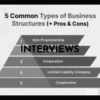So, You Want to be a Fashion Mogul? Buckle Up, Buttercup!
We all dream of seeing designs on runways or selling products online. Starting a clothing business can be rewarding, but it isn’t all glamour. Prepare for the hard work ahead. Let’s explore what you need to understand to jump in.
The Cold, Hard Cash: Understanding the Costs
Money is essential in business. Your clothing venture needs funds, so let’s clarify expenses.
Initial Costs: Getting Off the Ground
These are your launchpad costs. No rocket means no flight, and no investment means no sales.
Online Store Front: Your Digital Runway
Looking to be an e-commerce expert? Here’s what you need:
- Website Development/Platform: Use platforms like Shopify or Etsy for easy setup. Customization and special features come with a cost.
- Design and Branding: A stunning logo and graphics? If design isn’t your strength, hire someone. First impressions count.
- Inventory: You can’t sell empty boxes. Build your initial clothing collection based on your target market.
- Photography: Blurry photos? No thanks. Professional images are a must. Consumers shop with their eyes first.
Retail Store Front: Bricks and Mortar Dreams
Want a physical store? Prepare for higher startup costs. Don’t say we didn’t warn you.
- Rent/Lease: Commercial rent is high. Utilities and maintenance add up. Empty storefronts don’t pay rent.
- Store Fixtures: Racks, shelves, mannequins – they create your sales environment and can be costly.
- Inventory: Like online, you need clothes to sell. Fill the store to attract foot traffic.
- Point of Sale (POS) System: Cash registers are outdated. Invest in a POS system for transactions. It’s vital.
- Signage and Interior Design: Make your store inviting. Signage and a pleasing interior attract customers.
Ongoing Costs: Keeping the Machine Running
The bills won’t stop after opening. These recurring costs keep your clothing business alive.
- Production Costs: This is where the magic happens.
- Raw Materials: Costs change with fabric, zippers, and buttons. Stay sharp and negotiate.
- Labor: Sewing and cutting involve costs. Whether in-house or outsourced, labor is a key factor.
- Manufacturing Costs: If you create clothes, consider machinery, space rent, and utilities. They add up quickly.
- Marketing and Advertising: Building it won’t guarantee customers. Ads, campaigns, and print media all cost money.
- Shipping and Handling: Getting garments to customers incurs shipping costs. Don’t forget packaging; presentation matters.
- Inventory Management: It’s not free to store inventory. You’ll need space, software, and possibly staff for management.
- Legal and Accounting Fees: Registration, permits, and legal advice always carry costs. A good accountant helps avoid tax issues.
- Staff Salaries (if applicable): Hiring involves salaries, benefits, and taxes. These costs are crucial if you want to grow.
LLC: Your Business Shield (or Is It?)
LLC stands for Limited Liability Company. It separates your personal money from business finances. Let’s understand why, when, and how to form one.
The Perks of the LLC Life
Why create an LLC? Here are some benefits:
- Liability Protection: Without an LLC, you are liable for debts and lawsuits. LLC protects personal assets like savings and your house.
- Professionalism and Credibility: “Sarah’s T-Shirt Shop” sounds less serious than “Sarah’s T-Shirt Shop, LLC.” LLC gives a professional edge that impresses customers and lenders.
- Separation of Finances: Don’t mix business and personal finances; it leads to chaos. An LLC simplifies tracking and management.
- Tax Advantages: An LLC may offer tax benefits. Talk to a tax advisor for specifics, as it varies by structure.
- Ease of Operations: Need a bank account or loans? LLC status streamlines these tasks for banks and lenders.
Hold Up, Maybe You Don’t Need an LLC Just Yet…
Sometimes, an LLC is too much. Let’s discuss when to consider waiting.
- Small, Low-Risk Ventures: Selling a few handmade items might be fine as a sole proprietorship. Low risks mean LLC paperwork can wait.
- Early Stages of Hustle: Testing your brand? You can operate without an LLC initially. Form one later when things stabilize.
LLC Formation: The Nitty-Gritty Steps
Ready for an LLC? Follow these steps:
- Choose a Business Name: Be creative, but ensure availability in your state for uniqueness.
- Register Your Business: Time for paperwork! File documents with your state’s Secretary of State.
- Obtain an EIN: This acts as your business’s social security number. Get an Employer Identification Number (EIN) for banking.
- Create an Operating Agreement: Consider this your business rulebook. Define how the LLC will operate.
- Open a Business Bank Account: Separate personal and business funds by opening a business account under your LLC.
Show Me the Money: Is a Clothing Business Profitable?
Can you make money in the clothing industry? The short answer is yes, but do not expect instant riches.
Profit Potential: The Good News
- High Potential Market: Clothing is always in demand. A well-run business can prosper in this vast market.
- Profit Margins: Retail margins often range from 40% to 60%. But remember, net profit margins are usually lower due to expenses.
- Factors in Your Favor: Hit the right trends, market well, and manage costs to increase profit chances.
Reality Check: The Challenges Are Real
- Competitive Jungle: The clothing market is cutthroat. Compete with big brands and numerous boutiques.
- Trend Rollercoaster: Fashion changes quickly. Stay current to remain relevant but be cautious of risks.
- Cost Control is King: Manufacturing and marketing costs can spiral. Managing these costs ensures profitability.
- Online Competition is Fierce: With e-commerce booming, there’s more competition. Effective marketing is critical.
Keys to Unlock Profitability: Your Success Checklist
- Trend Radar: Monitor trends closely. Understanding styles and customer desires is vital.
- Marketing Muscle: In a crowded market, attracting customers relies on effective marketing strategies.
- Cost-Conscious Mindset: Every dollar counts. Manage expenses vigilantly! Keep focused on profitability throughout your journey.
- Penny counts. Good cost management in production drives profits in clothing.
- Brand Power: A strong brand identity helps you stand out. Identify what makes your brand unique and desirable.
- Customer Love: Happy customers return and market for you. Provide a great customer experience to build loyalty.
Blueprint for a Brand: Start
Ready to start your clothing brand? Here’s your step-by-step guide.
Step 1: Craft Your Business Plan
A business plan is essential. It acts as your roadmap to success. Don’t skip this.
- Define Your Brand DNA: Your vision, mission, target audience—define who you are and what you stand for.
- Market Research Deep Dive: Analyze trends, competitors, and customer needs. Know your market and potential clients.
- Business Structure Decision: Choose a legal structure: sole proprietorship, LLC, or corporation. Consider liability and taxes.
- Financial Projections: Calculate startup, production costs, and revenue forecasts. Realistic projections help with planning.
- Marketing Masterplan: Detail how you’ll reach your audience. Include online, offline, social media, and PR strategies.
Step 2: Design Your Clothing Line
Let’s turn your designs into wearable items.
- Design: Create a cohesive collection reflecting your brand identity. Use sketches, mood boards, and samples.
- Source Your Fabrics: Choose materials aligning with designs and budget. Quality impacts brand perception.
- Find Your Production Partner: Decide between in-house or outsourcing. Locate reliable manufacturers or opt for DIY. This guide offers more insights on starting a clothing brand.
Step 3: Build Your Brand and Online Presence
Your brand offers an experience. Online presence serves as your storefront to the world.
- Craft a Killer Website: A professional website is essential. Ensure it showcases your brand and products well.
- Develop a Solid Brand Identity: Create a memorable name, logo, and style that resonate with your audience. Brand recognition is key.
- Social Media Domination: Build a robust social media presence. Engage with your audience and promote across platforms.
Step 4: Market and Sell
It’s time to sell your creations.
- Develop a Marketing Blitz: Execute your marketing plan. Use various channels to reach your audience.
- E-commerce Platform Power: Set up an online store for direct sales. Make the shopping experience user-friendly.
- Explore Retail Partnerships: Partner with boutiques that fit your brand aesthetic. Wholesale can broaden reach and visibility. Thinking of a boutique? This might help with costs.
- Customer Service Focus: Provide excellent customer service. Happy clients become loyal fans. Make them feel valued.
Step 5: Legal and Business Check
The legal side is crucial too.
- Register Your Business: Obtain required licenses and permits to operate legally. Compliance avoids future headaches.
- Protect Your Intellectual Property: Register trademarks for your brand name and designs. Protect creative assets from theft. Early trademarking is key to avoid costly lessons later.
- Understand Tax Obligations: Consult a professional to know your tax obligations and remain compliant. Smart tax planning minimizes pain.
Tips for Success: Advice for Brand Growth
A few tips to guide you in building a successful clothing brand.
- Brand Authenticity: Remain true to your core values. Consistency in messaging builds trust.
- Be Adaptable: Flexibility is critical based on market feedback. Rigidity can lead to problems.
- Network Effectively: Build relationships with industry professionals. Connections can offer support.
- Quality Over Everything: Prioritize strong product quality. Well-made items build trust and justify costs.
- Experiment and Innovate: Try new ideas to keep your brand fresh. Innovation attracts interest. Starting from home? This guide may help.
Bonus Round: More Knowledge Nuggets
A few additional tips to enhance your journey in building a clothing brand.
- Most Profitable Threads: Everyday staples like jeans and t-shirts are popular items. Consider what people wear regularly.
- Budget Estimation: Starting a clothing brand in India can cost ₹5 lakh to ₹10 lakh. Don’t underestimate initial investment needs.
- Selling Without an LLC? You can sell online without an LLC but consider liability protection benefits.
- Write-Off Opportunities: Clothes not suitable for wear outside business can be written off as expenses. Think branded uniforms.
- Fixed Cost Insights for Manufacturers: Rent, utilities, machinery costs are constant, regardless of production levels.
- Sourcing Strategies: Look for suppliers online, at market expos, and fabric mills. Compare to find the best deals.
- Current Trends: Stay informed on items like stripes and maxi skirts that are currently popular. Trends change quickly.
- Niche Market Potential: Specialty products often have higher margins. Find lucrative niches to explore.
- Sustainable Profitability: Aim for a profit margin of 30-60% for clothing businesses to be sustainable.
- Trademarking Costs: Trademarking your logo starts around $350 for an online application with the USPTO. Budget for protection costs.
- Selling on Amazon Basics: An EIN is needed for taxes if selling on Amazon, but an LLC isn’t necessary.
Your fabric costs will vary significantly based on type and quality. Research to optimize expenses effectively.
The strongest form of protection for brand names is trademark registration. Protect your brand identity actively.New clothing brands demand passion, planning, and hustle. With knowledge and courage, make your fashion dreams a reality! Go create some fashion magic!





